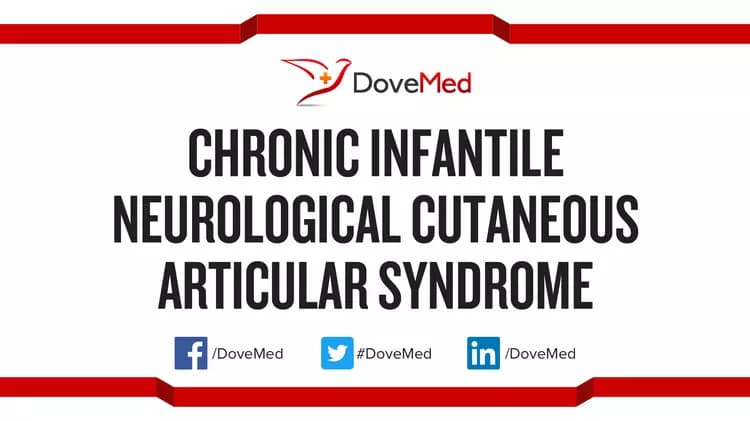
Chronic Infantile Neurological Cutaneous Articular Syndrome
What are the other Names for this Condition? (Also known as/Synonyms)
- CINCA Syndrome
- Infantile-Onset Multisystem Inflammatory Disease (IOMID)
- Neonatal-Onset Multisystem Inflammatory Disease (NOMID)
What is Chronic Infantile Neurological Cutaneous Articular Syndrome? (Definition/Background Information)
- Chronic Infantile Neurological Cutaneous Articular Syndrome (CINCA Syndrome) is an extremely rare genetic disorder presenting cutaneous and neurological manifestations. This congenital condition is characterized by skin rashes, fever, fatigue, bone and joint abnormalities, and hearing and vision impairment. An involvement of the NLRP3 gene that causes cryopyrin associated periodic syndromes (CAPS) is noted; CINCA Syndrome is reportedly the most severe form of CAPS
- A lifelong management of the disorder is necessary to improve outcomes and one’s quality of life. The treatment of Chronic Infantile Neurologic Cutaneous Articular Syndrome may involve the administration of medications (interleukin-1 beta receptor antagonists or antibodies that block the action of interleukin-1 beta on receptors), surgery, use of hearing and vision aids, and physical and cognitive therapy and support
Who gets Chronic Infantile Neurological Cutaneous Articular Syndrome? (Age and Sex Distribution)
- Chronic Infantile Neurological Cutaneous Articular Syndrome is a very rare congenital disorder, and the presentation of symptoms occur at birth
- The prevalence of CINCA Syndrome is about 1-2 cases per million population
- Both males and females may be affected
- Worldwide, individuals of all racial and ethnic groups may be affected
What are the Risk Factors for Chronic Infantile Neurological Cutaneous Articular Syndrome? (Predisposing Factors)
- A positive family history may be an important risk factor, since Chronic Infantile Neurological Cutaneous Articular Syndrome can be inherited
- Currently, no risk factors have been clearly identified for CINCA Syndrome
It is important to note that having a risk factor does not mean that one will get the condition. A risk factor increases one’s chances of getting a condition compared to an individual without the risk factors. Some risk factors are more important than others.
Also, not having a risk factor does not mean that an individual will not get the condition. It is always important to discuss the effect of risk factors with your healthcare provider.
What are the Causes of Chronic Infantile Neurological Cutaneous Articular Syndrome? (Etiology)
Chronic Infantile Neurological Cutaneous Articular Syndrome (CINCA Syndrome) is caused by genetic abnormalities that occur sporadically, meaning these are new mutations and no preceding family history is seen.
- It is caused by mutations involving the NLRP3 gene (or CIAS1 gene) in over 50% of the cases. The mutations result in a group of disorders called cryopyrin associated periodic syndromes (CAPS)
- The causative gene encodes for a protein called cryopyrin, which plays an important immune system function. The protein is found in the white blood cells and chondrocytes
- Abnormalities in the protein results in the characteristic signs and symptoms of the disorder. The most severe form of CAPS is CINCA Syndrome
Rare cases have been reported where CINCA Syndrome is passed down (through families) in an autosomal dominant pattern.
Autosomal dominant mode of inheritance: Autosomal dominant conditions are traits or disorders that are present when only one copy of the mutation is inherited on a non-sex chromosome. In these types of conditions, the individual has one normal copy and one mutant copy of the gene. The abnormal gene dominates, masking the effects of the correctly function gene. If an individual has an autosomal dominant condition, the chance of passing the abnormal gene on to their offspring is 50%. Children, who do not inherit the abnormal gene, will not develop the condition or pass it on to their offspring.
What are the Signs and Symptoms of Chronic Infantile Neurological Cutaneous Articular Syndrome?
The signs and symptoms of Chronic Infantile Neurological Cutaneous Articular Syndrome may vary among affected individuals in type and severity, and may include the following:
- Fever
- Headache
- Fatigue
- Nausea and vomiting
- Sensorineural hearing impairment
- Presence of severe skin rashes
- Joint and muscle pain
- Swollen lymph nodes
- Vision impairment
- Blood disorders
- Bone abnormalities
- Liver and spleen enlargement
How is Chronic Infantile Neurological Cutaneous Articular Syndrome Diagnosed?
Chronic Infantile Neurological Cutaneous Articular Syndrome is diagnosed on the basis of the following information:
- Complete physical examination with evaluation of family medical history
- Blood tests such as complete blood count (CBC), erythrocyte sedimentation rate (ESR), and C-reactive protein (CRP)
- Neurological assessment
- Dermoscopy: It is a diagnostic tool where a dermatologist examines the skin using a special magnified lens
- Wood’s lamp examination: In this procedure, the healthcare provider examines the skin using ultraviolet light. It is performed to examine the change in skin pigmentation
- Skin biopsy: A skin biopsy is performed and sent to a laboratory for a pathological examination. The pathologist examines the biopsy under a microscope. After putting together clinical findings, special studies on tissues (if needed) and with microscope findings, the pathologist arrives at a definitive diagnosis
- Molecular genetic testing to check for or confirm specific causative gene mutation(s)
- Prenatal testing in pregnant women
A differential diagnosis may be necessary to eliminate other conditions that present similar signs and symptoms. This may include:
- CANDLE syndrome
- Mevalonate kinase deficiency (MKD) disorder
- Systemic onset juvenile idiopathic arthritis
- TNF-receptor associated periodic fever (TRAPS)
Many clinical conditions may have similar signs and symptoms. Your healthcare provider may perform additional tests to rule out other clinical conditions to arrive at a definitive diagnosis.
What are the possible Complications of Chronic Infantile Neurological Cutaneous Articular Syndrome?
The complications of Chronic Infantile Neurological Cutaneous Articular Syndrome may include:
- Hydrocephalus (increased intracranial pressure) and macrocephaly (abnormally increased head size)
- Meningitis
- Growth failure
- Premature birth
- Bone erosion
- Speech and hearing loss
- Total loss of vision
- Renal amyloidosis
- Intellectual impairment
Complications may occur with or without treatment, and in some cases, due to treatment also.
How is Chronic Infantile Neurological Cutaneous Articular Syndrome Treated?
There is no cure for Chronic Infantile Neurological Cutaneous Articular Syndrome since it is a genetic condition. The treatment is usually given to manage the signs and symptoms and any complication that develops. The treatment methods may include:
- Administration of anti-interleukin-1 beta medications such as Rilonacept and Anakinra
- Use of less specific anti-inflammatory agents including corticosteroids
- Surgery to correct defects, as necessary
- Kidney transplantation, if necessary
- Use of hearing and vision aids
- Physical and cognitive therapy
- Speech and psychomotor therapy
Regular medical screening at periodic intervals with tests and physical examinations are recommended.
How can Chronic Infantile Neurological Cutaneous Articular Syndrome be Prevented?
Currently, Chronic Infantile Neurological Cutaneous Articular Syndrome may not be preventable since it is a genetic disorder.
- Genetic testing of the expecting parents (and related family members) and prenatal diagnosis (molecular testing of the fetus during pregnancy) may help in understanding the risks better during pregnancy
- If there is a family history of the condition, then genetic counseling will help assess risks, before planning for a child
- Active research is currently being performed to explore the possibilities for treatment and prevention of inherited and acquired genetic disorders
What is the Prognosis of Chronic Infantile Neurological Cutaneous Articular Syndrome? (Outcomes/Resolutions)
- The prognosis of Chronic Infantile Neurological Cutaneous Articular Syndrome is dependent upon the severity of the signs and symptoms and associated complications, if any
- In many individuals, the condition affects several body systems and presents severe complications. The overall prognosis is typically guarded and depends on early diagnosis and adequate management of the syndrome
Additional and Relevant Useful Information for Chronic Infantile Neurological Cutaneous Articular Syndrome:
The following DoveMed website link is a useful resource for additional information:
Related Articles
Test Your Knowledge
Asked by users
Related Centers
Related Specialties
Related Physicians
Related Procedures
Related Resources
Join DoveHubs
and connect with fellow professionals


0 Comments
Please log in to post a comment.